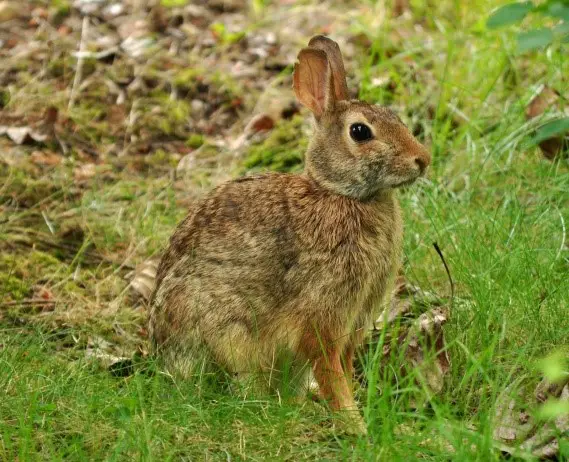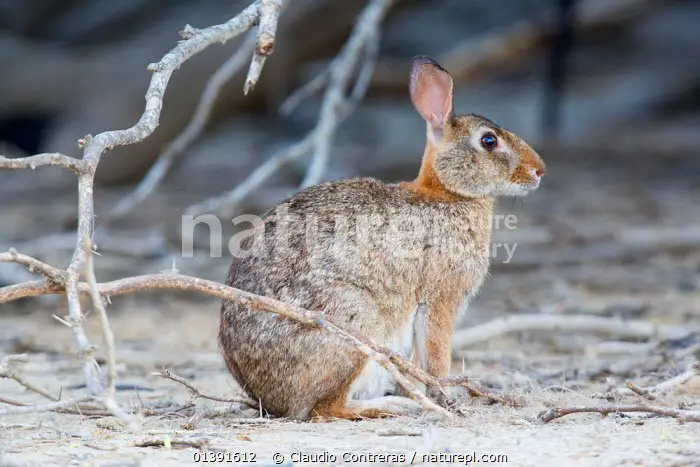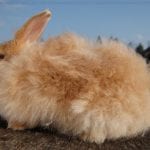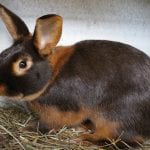Scientific Facts
| Common Name | Tres Marias Rabbit |
| Scientific Name | Sylvilagus Graysoni |
| Life Span | Less than three years |
| Size (Adult) | 43 centimeters |
| Weight (Adult) | 960 grams |
| Body Shape | Medium to large-sized rabbit |
| Habitat | Tropical dry/subtropical and forest |
| Country of Origin | Mexico |
Physical Description

Tres Marias Rabbit is classified as a medium-sized and large-sized rabbit. This features brown, gray, and red fur. This also appears pale brown and red in the underside. This is, even more, characterized for its brown patch of fur right through its throat. While the tail it has is white below and brown above. Another impressive facet of the Tres Maria Rabbit is that it does not turn white even when the winter season comes.
It has an average length both in the head and body that ranges from 215 to 471 millimeters. It also has a tail length that differs from 15 to 60 millimeters. When compared to other cottontail rabbits, this one has short ears measuring 57-millimeters long. Its hindfoot also averages in length of 95-millimeters.
It simply is paler reddish with its venter in white. Its throat patch is brown. Having to look at its skull, it somehow is medium-sized up to large. There is a long diastema, long rostrum, and long, incisive foramina.
Digging down deeper, the internal part of the rabbit is the maxillary toothrow that is short while the basioccipital is narrow. Its posterior extensions are connected to the braincase up to its length. The female Tres Marias Rabbit has 4 or 5 pairs of mammae. There also is no such thing as sexual dimorphism. It is just that the adult female is slightly larger than the adult male.
Distribution
Tres Maria Rabbit is an insular kind of specie having been known for its limited distribution in the Tres Marias Islands, Nayarit. This is a 100-kilometer off the west coast of Mexico. The popularity of the rabbit extends up until the Maria Magdalena, Maria Madre, and Maria Cleofas Islands. Its elevational records have so far been documented to be at the seal level to ca.350-meters. No fossils have ever been found to the Tres Maria Rabbit.
Function and Form
When you go inspect the skin of the Tres Maria Rabbit, you’ll realize how delicate it could be. It somehow is difficult to specify it without tearing it up. It is impossible as well to carry a specimen with the hind legs at a short distance without tearing the skin and slipping it. Its dental formula comes in different measurements of 2/1, c 0/0, p 3/2, and m 3/3, and a total of 28.
Fast Facts
Best Suited: Habitat consisting of trees, bushes, and dense vegetation
Temperament: Terrestrial, Motionless
Comparable Breeds: European Rabbits
Colors

It has a brown and grey color highlighted by a paler color underside that makes it all the more appealing. Its throat has a brown patch of fur. The tail is brown on the upperside with white down below.
Lifestyle and Behavior
Tres Marias Rabbit is known for being terrestrial. It remains motionless for about fifteen minutes once when approached. It is something unique that will amaze you more of it.
What more to know is that it is generally nocturnal. It also can be seen during the day. It just stays active the entire year. This specie tends to move around often coined out for a bunny hop.
This rabbit is not classified to be something like a solitary or social specie. But it is known that the male pursues the female, and together they engage in the breeding season.
The female rabbit excavates a protective shelter for the rearing of its young. The mother will dig a hole that is approximately one-hundred fifty millimeters deep and one-hundred twenty millimeters wide. It lines up the soft fur and plants right below its side. The nest is prepared for the baby rabbit to stay safe and warm. The female sits right above the hole while the newborn tries to climb on top to feed on its milk.
Dating back in the past century, the Tres Marias Rabbit is just so abundant that it stays in the old fields on the northern end of the Maria Madre island. It also often can be observed sitting in the forms under bushes. When you drive it out into an open space, it will just sit quietly. It occurred more sparingly with other cottontails in the scattered bushes.
Habitat
The main habitat of the Tres Marias Rabbit is comprised of dense vegetation, bushes, and trees. This thrives in those areas providing cover. But it never likes it staying in the open fields.
What it does most is seeking shelter in the burrows built by other animals. That would also include under the piles of the brush and just within the vegetation.
But the main habitat there is known for Tres Marias Rabbit is the Tres Marias Islands off the Mexico Coast. It also dominantly stay in the tropical dry but deciduous and moist forests. These are then characterized by the dense cover having so many tree species.
Food Habits
This cottontail rabbit feeds on a wide range of herbaceous species and plant materials. Its diet consists of twigs and bark during the colder months of the year.
This is the same as other rabbit species that excrete 2 kinds of fecal. Its green and soft pellets can be re-ingested for best absorption of vitamin B. This also can be extracted after the food has been digested already.
Reproduction
There is so far little information cited about the reproduction of the Tres Marias Rabbit. Even its number of young for every birth, gestation period, and a number of litters are yet unknown.
No specific year birth has ever been mentioned about the rabbit. That also includes the weight, the length, and the degree of development of the neonate.
Not much of the information is cited as well before the mating systems and the estrous cycles of the females.
Genetics
Its karyotype consists 2n= 42 while FN= 78. Its autosomal complement includes fifteen pairs of small-to-medium submetacentric and metacentric chromosomes. There also are 5 pairs of subtelocentric chromosomes or small acrocentric. These five pairs also may bear the satellites on the short arms.
About the X chromosome, it is small subtelocentric, or acrocentric. This is where the Y functions as a small acrocentric. The diploid number of S. cunicularius is shared with the S.graysoni, S.audubonii, and S. cunicularius. This best supports the hypothesis of kinship between the 2 species.
Ecology
This rabbit mainly stays in the arid region than the mainland. This region has an average rainfall of about 635 mm that falls during the summer season. It also often during the violent storms beginning the southeast. The temperature is moderate, with a monthly average of about 20.3 Degree Celsius in the months of January to February. While in July and August, it falls at around 28.1 Degrees Celsius. The recorded extremes are at a range of 4.6 Degree Celsius and 37.5 Degree Celsius.
Such a tranquil rabbit, catch it as you want it easily. It holds no fear of humans. Its extreme tameness is may be attributed to the dearth of predators. Its predators include red-tailed hawks, raccoons, and caracaras. They are the only known predators of the Tres Marias Rabbit.
Their lack of escape is very much apparent in this rabbit. This rabbit to find in other islands show less fear to humans than the San Juanito island.
San Juanito island is by far the smallest island to see. It also is a northwesternmost island that is separated from Maria Madre. That is brought about by the shallow channel that is 3-kilometers wide. The island is flat with access to the interior that is made impossible due to the thickness in cacti. Its elevated portion is mainly covered by the dense stands of bushes, agaves, and trees.
No known humans have been seen inhabiting this island. This is because of the lack of fresh water. Despite its abundance in the four islands at the start of the century, it was then found out that the specie was abundant on San Juanito island. It also still can be found on the other islands. It is just that they can never be found in large numbers.
Now the biggest island of the archipelago is Maria Madre. It is 5 to 10 kilometers wide, having a maximum elevation of .600 m. Its natural vegetation is in the tropical forest with a height of about 4-meters. Only that these forests are removed by humans. The interior part of the island still was forested with trees reaching up to 30meters. The timber that can be harvested there already have been removed.
Conservation Status
Tres Marias Rabbit started to flourish in the entirety of the Tres Marias Islands. This started at the beginning of the century. In the latest survey of the specie in 1976, its population had so far dropped significantly.
In the past ten years, the population has been reduced by almost fifty percent. This is the trend that is expected to still continue.
The specie also has evolved in an environment that is free from a predator. It is not likely to run away when approached by us humans. This rabbit is hunted by humans with no difficulty.
Some of the threats to its survival include habitat modification. The clearing of the vegetation and the introduction of new species that include the goats and pigs led to the scarcity of the Tres Marias Rabbit. Even humans settling in the place also contributed to their conservation status.
Surveys have also been documented following their present status as species. Research has it that the hopes are still high in regarding their preservation.
Economic Importance to Humans-The Negative
No such information has been presented following the Tres Marias Rabbit negatively affecting humans. Although there is documentation of the cottontail rabbit specie bringing damage to the crops, shrubs, and forest plantations.
Economic Importance to Humans-The Positive
This cottontail rabbit is hunted by the people. This is beneficial in the sense that it provides games for valuable furs and hunters. Its body parts are also a good source of some valuable material.
This is an endangered specie because of some of the threats imposed on its survival. Extensive hunting and modification of its habitat contribute to its existence being affected. Pigs and goats that can already be found around. The ever-increasing settlements of humans that include the federal prison affect their existence.
The survival of the rabbit is still recommended to be prioritized. San Juanito Island is proposed to be ecologically-preserved. That way, all hunting activities will be prevented and stopped at once. Status surveys will also be continuously conducted to determine the habitat requirements and the present status of the Tres Marias Rabbit. The proposal on the research of its population density and natural history in the long-term projects is also more likely to materialize.
Remarks
Tres Marias Rabbit is related to the S. cunicularious of the mainland. It could have been possible that its ancestral stock has reached the islands during the earlier period of the land connected to the island.
When the Tres Marias Rabbit has finally become established in all four islands, its population on San Juanito Island turned into isolation. The distinct population is enough to warrant subspecific recognition.
In 1985, the first specimen of Tres Marias Rabbit was collected by Grayson. It was then shipped to the known museum in America that is aimed at the preservation of natural history. It was J.A. Allen who named it after him.
The holotype, or the adult Tres Marias Rabbit female, is housed in the U.S National Museum of Natural History. Badistes is a Greek word that often refers to the unusual lack of escapism as its behavior.
FAQs
What does the Tres Marias Rabbit Eat?
The Tres Marias Rabbit eats shrubs and grasses. They also feed on bark and twigs.
Does the Tres Marias Rabbit Make a Good Pet?
There is never information shared that it makes a good pet. But, it survives in the idea of being a wild rabbit.
Does the Tres Marias Rabbit always move around?
Yes. The Tres Marias Rabbit always moves around, having some sort of coordination.
Does the rabbit cry?
Yes, it can be heard in a peculiar and prolonged cry. What more, it also can be noticed in its weak melodious squeak.
What are the threats to the decline of the rabbit?
There are some major threats known to the decline of the rabbit. These include the introduced species like the house rats and other inhabitants of the islands. They would prey upon the rabbits along with domestic goats, and white-tailed deer. They all compete for native vegetation and food.

